Product Costing and Pricing Doc
VerifiedAdded on 2020/03/16
|8
|2193
|96
AI Summary
Contribute Materials
Your contribution can guide someone’s learning journey. Share your
documents today.
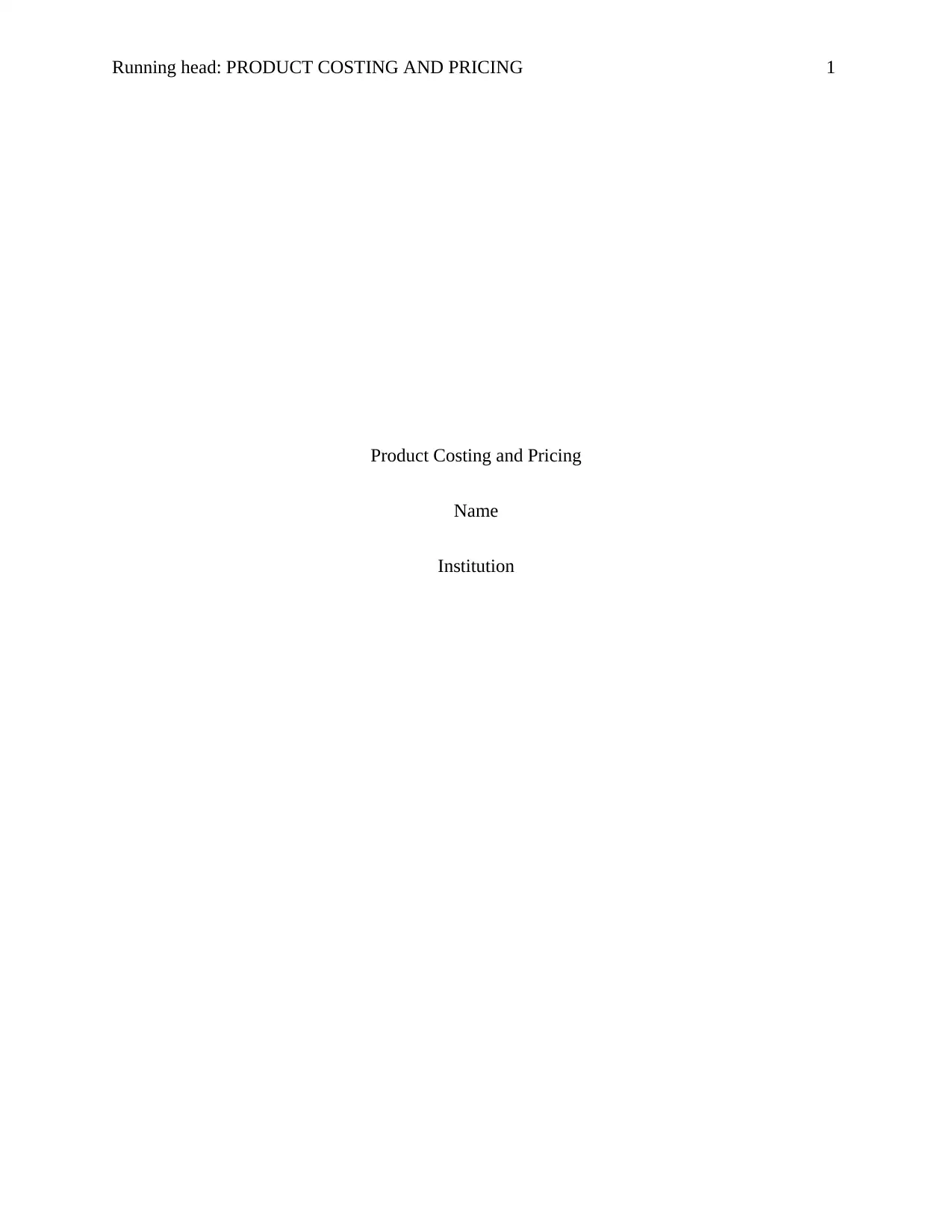
Running head: PRODUCT COSTING AND PRICING 1
Product Costing and Pricing
Name
Institution
Product Costing and Pricing
Name
Institution
Secure Best Marks with AI Grader
Need help grading? Try our AI Grader for instant feedback on your assignments.
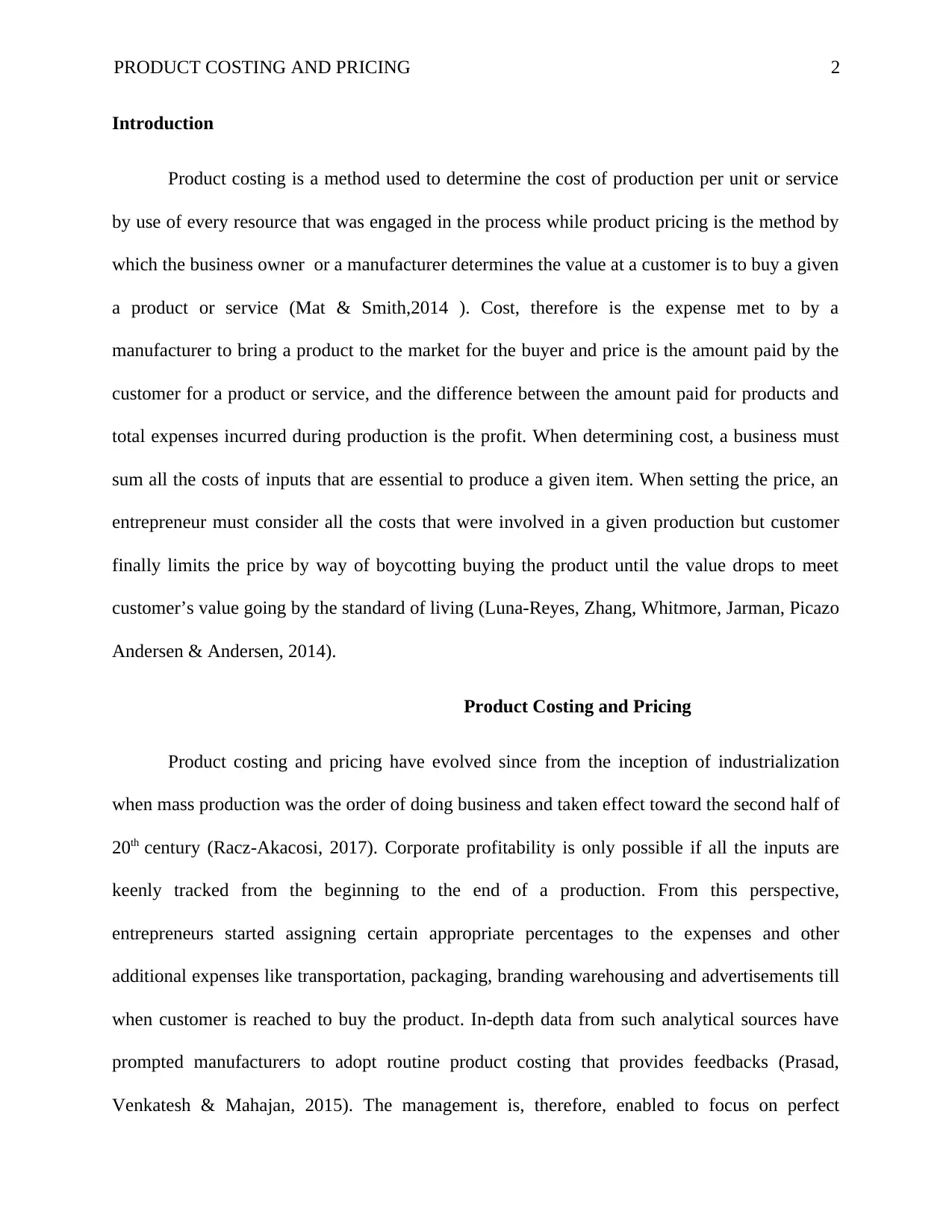
PRODUCT COSTING AND PRICING 2
Introduction
Product costing is a method used to determine the cost of production per unit or service
by use of every resource that was engaged in the process while product pricing is the method by
which the business owner or a manufacturer determines the value at a customer is to buy a given
a product or service (Mat & Smith,2014 ). Cost, therefore is the expense met to by a
manufacturer to bring a product to the market for the buyer and price is the amount paid by the
customer for a product or service, and the difference between the amount paid for products and
total expenses incurred during production is the profit. When determining cost, a business must
sum all the costs of inputs that are essential to produce a given item. When setting the price, an
entrepreneur must consider all the costs that were involved in a given production but customer
finally limits the price by way of boycotting buying the product until the value drops to meet
customer’s value going by the standard of living (Luna-Reyes, Zhang, Whitmore, Jarman, Picazo
Andersen & Andersen, 2014).
Product Costing and Pricing
Product costing and pricing have evolved since from the inception of industrialization
when mass production was the order of doing business and taken effect toward the second half of
20th century (Racz-Akacosi, 2017). Corporate profitability is only possible if all the inputs are
keenly tracked from the beginning to the end of a production. From this perspective,
entrepreneurs started assigning certain appropriate percentages to the expenses and other
additional expenses like transportation, packaging, branding warehousing and advertisements till
when customer is reached to buy the product. In-depth data from such analytical sources have
prompted manufacturers to adopt routine product costing that provides feedbacks (Prasad,
Venkatesh & Mahajan, 2015). The management is, therefore, enabled to focus on perfect
Introduction
Product costing is a method used to determine the cost of production per unit or service
by use of every resource that was engaged in the process while product pricing is the method by
which the business owner or a manufacturer determines the value at a customer is to buy a given
a product or service (Mat & Smith,2014 ). Cost, therefore is the expense met to by a
manufacturer to bring a product to the market for the buyer and price is the amount paid by the
customer for a product or service, and the difference between the amount paid for products and
total expenses incurred during production is the profit. When determining cost, a business must
sum all the costs of inputs that are essential to produce a given item. When setting the price, an
entrepreneur must consider all the costs that were involved in a given production but customer
finally limits the price by way of boycotting buying the product until the value drops to meet
customer’s value going by the standard of living (Luna-Reyes, Zhang, Whitmore, Jarman, Picazo
Andersen & Andersen, 2014).
Product Costing and Pricing
Product costing and pricing have evolved since from the inception of industrialization
when mass production was the order of doing business and taken effect toward the second half of
20th century (Racz-Akacosi, 2017). Corporate profitability is only possible if all the inputs are
keenly tracked from the beginning to the end of a production. From this perspective,
entrepreneurs started assigning certain appropriate percentages to the expenses and other
additional expenses like transportation, packaging, branding warehousing and advertisements till
when customer is reached to buy the product. In-depth data from such analytical sources have
prompted manufacturers to adopt routine product costing that provides feedbacks (Prasad,
Venkatesh & Mahajan, 2015). The management is, therefore, enabled to focus on perfect
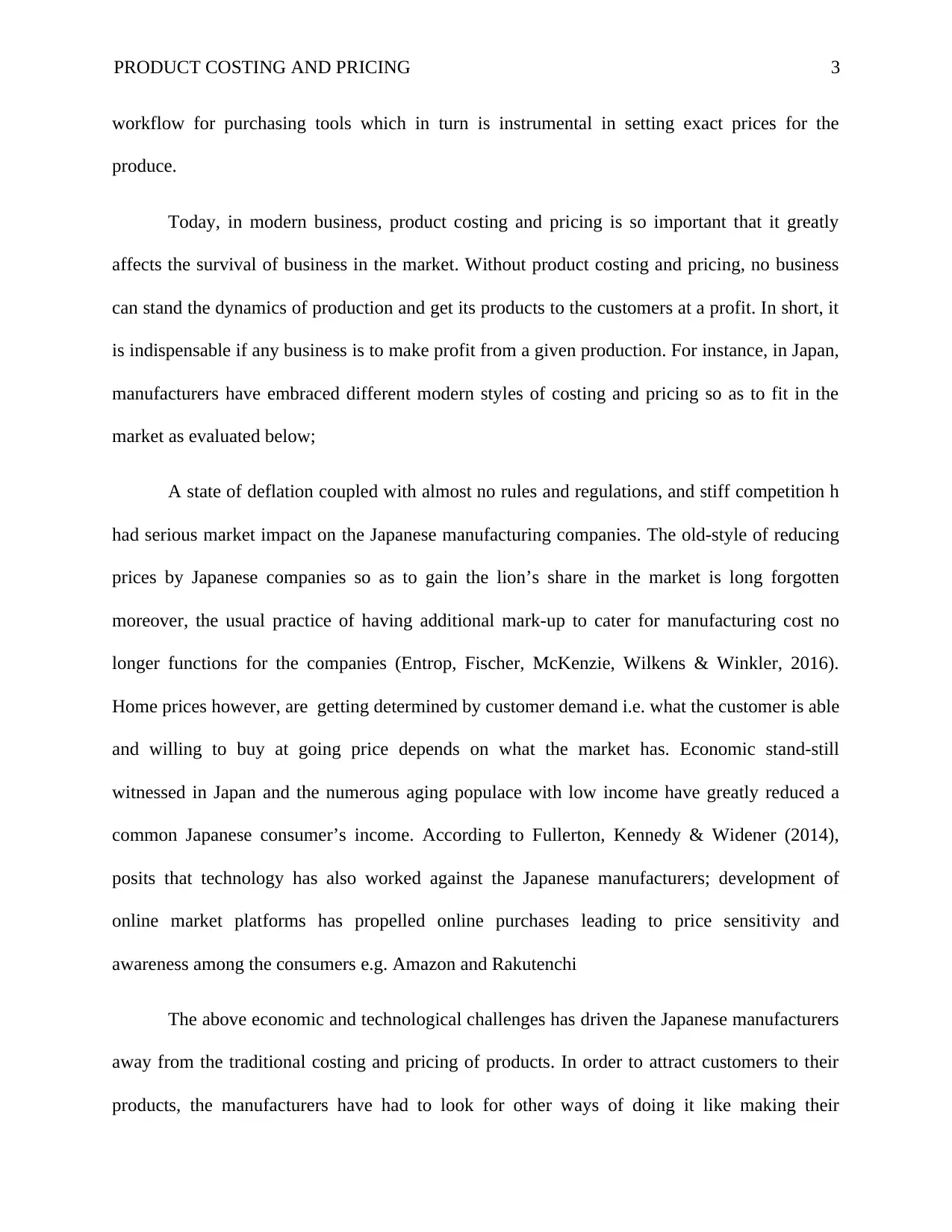
PRODUCT COSTING AND PRICING 3
workflow for purchasing tools which in turn is instrumental in setting exact prices for the
produce.
Today, in modern business, product costing and pricing is so important that it greatly
affects the survival of business in the market. Without product costing and pricing, no business
can stand the dynamics of production and get its products to the customers at a profit. In short, it
is indispensable if any business is to make profit from a given production. For instance, in Japan,
manufacturers have embraced different modern styles of costing and pricing so as to fit in the
market as evaluated below;
A state of deflation coupled with almost no rules and regulations, and stiff competition h
had serious market impact on the Japanese manufacturing companies. The old-style of reducing
prices by Japanese companies so as to gain the lion’s share in the market is long forgotten
moreover, the usual practice of having additional mark-up to cater for manufacturing cost no
longer functions for the companies (Entrop, Fischer, McKenzie, Wilkens & Winkler, 2016).
Home prices however, are getting determined by customer demand i.e. what the customer is able
and willing to buy at going price depends on what the market has. Economic stand-still
witnessed in Japan and the numerous aging populace with low income have greatly reduced a
common Japanese consumer’s income. According to Fullerton, Kennedy & Widener (2014),
posits that technology has also worked against the Japanese manufacturers; development of
online market platforms has propelled online purchases leading to price sensitivity and
awareness among the consumers e.g. Amazon and Rakutenchi
The above economic and technological challenges has driven the Japanese manufacturers
away from the traditional costing and pricing of products. In order to attract customers to their
products, the manufacturers have had to look for other ways of doing it like making their
workflow for purchasing tools which in turn is instrumental in setting exact prices for the
produce.
Today, in modern business, product costing and pricing is so important that it greatly
affects the survival of business in the market. Without product costing and pricing, no business
can stand the dynamics of production and get its products to the customers at a profit. In short, it
is indispensable if any business is to make profit from a given production. For instance, in Japan,
manufacturers have embraced different modern styles of costing and pricing so as to fit in the
market as evaluated below;
A state of deflation coupled with almost no rules and regulations, and stiff competition h
had serious market impact on the Japanese manufacturing companies. The old-style of reducing
prices by Japanese companies so as to gain the lion’s share in the market is long forgotten
moreover, the usual practice of having additional mark-up to cater for manufacturing cost no
longer functions for the companies (Entrop, Fischer, McKenzie, Wilkens & Winkler, 2016).
Home prices however, are getting determined by customer demand i.e. what the customer is able
and willing to buy at going price depends on what the market has. Economic stand-still
witnessed in Japan and the numerous aging populace with low income have greatly reduced a
common Japanese consumer’s income. According to Fullerton, Kennedy & Widener (2014),
posits that technology has also worked against the Japanese manufacturers; development of
online market platforms has propelled online purchases leading to price sensitivity and
awareness among the consumers e.g. Amazon and Rakutenchi
The above economic and technological challenges has driven the Japanese manufacturers
away from the traditional costing and pricing of products. In order to attract customers to their
products, the manufacturers have had to look for other ways of doing it like making their
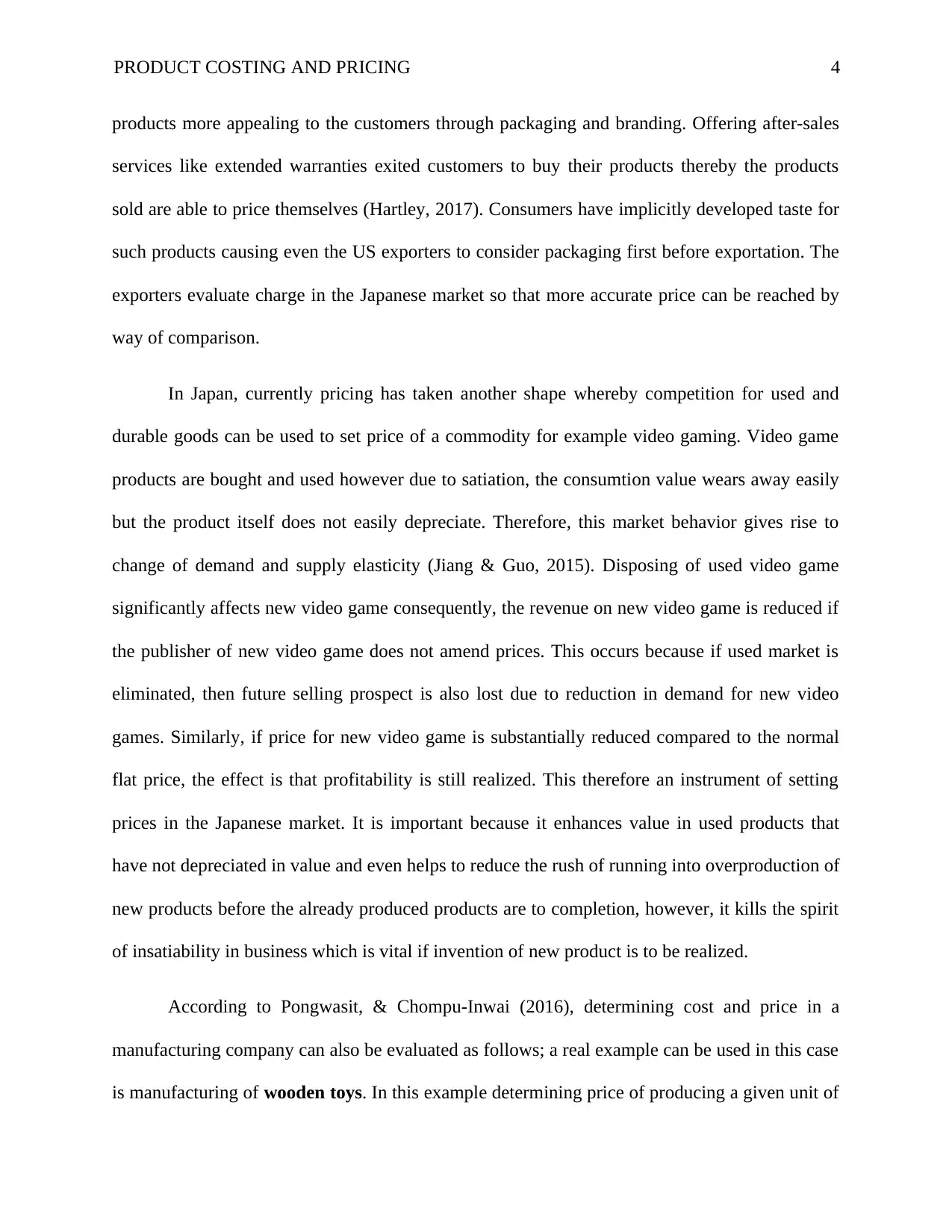
PRODUCT COSTING AND PRICING 4
products more appealing to the customers through packaging and branding. Offering after-sales
services like extended warranties exited customers to buy their products thereby the products
sold are able to price themselves (Hartley, 2017). Consumers have implicitly developed taste for
such products causing even the US exporters to consider packaging first before exportation. The
exporters evaluate charge in the Japanese market so that more accurate price can be reached by
way of comparison.
In Japan, currently pricing has taken another shape whereby competition for used and
durable goods can be used to set price of a commodity for example video gaming. Video game
products are bought and used however due to satiation, the consumtion value wears away easily
but the product itself does not easily depreciate. Therefore, this market behavior gives rise to
change of demand and supply elasticity (Jiang & Guo, 2015). Disposing of used video game
significantly affects new video game consequently, the revenue on new video game is reduced if
the publisher of new video game does not amend prices. This occurs because if used market is
eliminated, then future selling prospect is also lost due to reduction in demand for new video
games. Similarly, if price for new video game is substantially reduced compared to the normal
flat price, the effect is that profitability is still realized. This therefore an instrument of setting
prices in the Japanese market. It is important because it enhances value in used products that
have not depreciated in value and even helps to reduce the rush of running into overproduction of
new products before the already produced products are to completion, however, it kills the spirit
of insatiability in business which is vital if invention of new product is to be realized.
According to Pongwasit, & Chompu-Inwai (2016), determining cost and price in a
manufacturing company can also be evaluated as follows; a real example can be used in this case
is manufacturing of wooden toys. In this example determining price of producing a given unit of
products more appealing to the customers through packaging and branding. Offering after-sales
services like extended warranties exited customers to buy their products thereby the products
sold are able to price themselves (Hartley, 2017). Consumers have implicitly developed taste for
such products causing even the US exporters to consider packaging first before exportation. The
exporters evaluate charge in the Japanese market so that more accurate price can be reached by
way of comparison.
In Japan, currently pricing has taken another shape whereby competition for used and
durable goods can be used to set price of a commodity for example video gaming. Video game
products are bought and used however due to satiation, the consumtion value wears away easily
but the product itself does not easily depreciate. Therefore, this market behavior gives rise to
change of demand and supply elasticity (Jiang & Guo, 2015). Disposing of used video game
significantly affects new video game consequently, the revenue on new video game is reduced if
the publisher of new video game does not amend prices. This occurs because if used market is
eliminated, then future selling prospect is also lost due to reduction in demand for new video
games. Similarly, if price for new video game is substantially reduced compared to the normal
flat price, the effect is that profitability is still realized. This therefore an instrument of setting
prices in the Japanese market. It is important because it enhances value in used products that
have not depreciated in value and even helps to reduce the rush of running into overproduction of
new products before the already produced products are to completion, however, it kills the spirit
of insatiability in business which is vital if invention of new product is to be realized.
According to Pongwasit, & Chompu-Inwai (2016), determining cost and price in a
manufacturing company can also be evaluated as follows; a real example can be used in this case
is manufacturing of wooden toys. In this example determining price of producing a given unit of
Secure Best Marks with AI Grader
Need help grading? Try our AI Grader for instant feedback on your assignments.
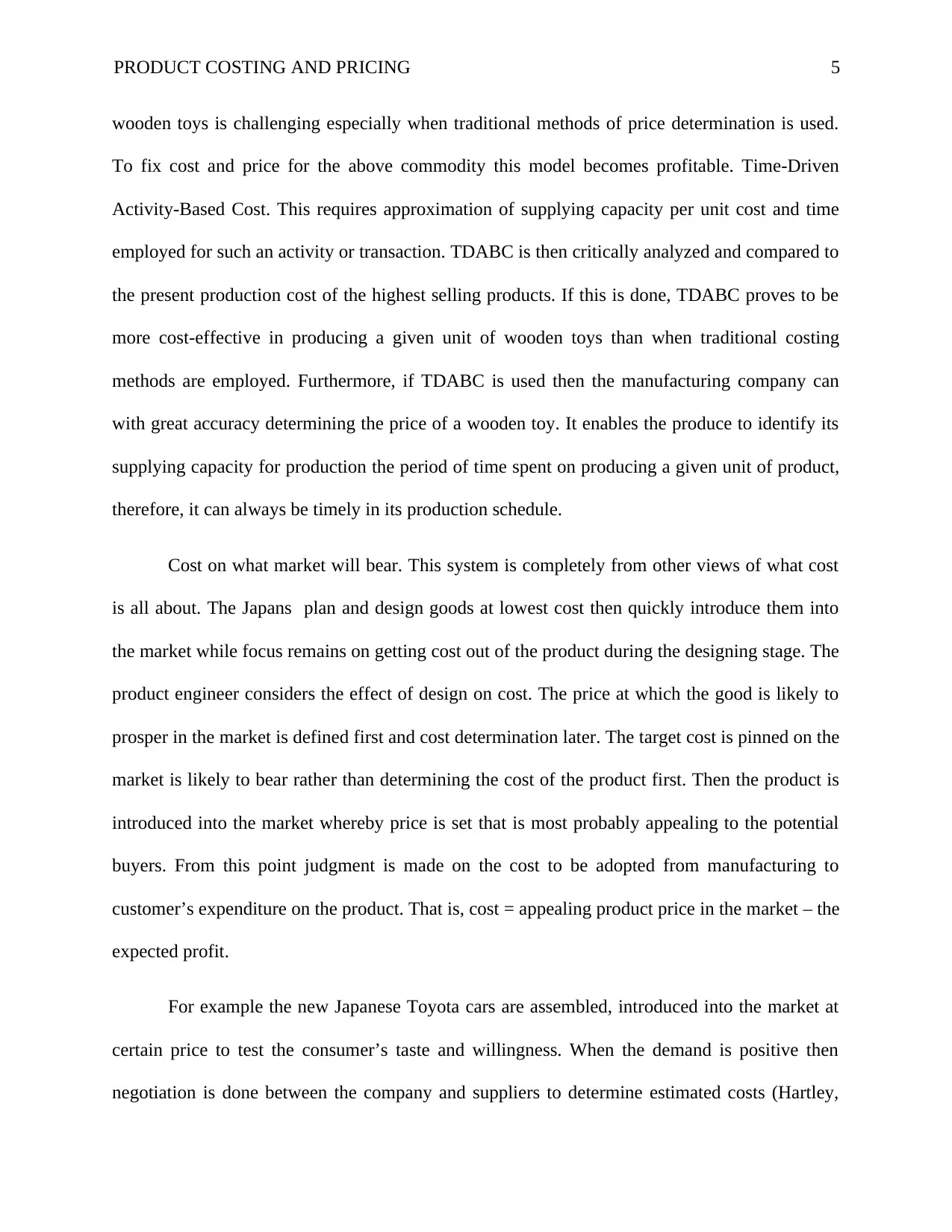
PRODUCT COSTING AND PRICING 5
wooden toys is challenging especially when traditional methods of price determination is used.
To fix cost and price for the above commodity this model becomes profitable. Time-Driven
Activity-Based Cost. This requires approximation of supplying capacity per unit cost and time
employed for such an activity or transaction. TDABC is then critically analyzed and compared to
the present production cost of the highest selling products. If this is done, TDABC proves to be
more cost-effective in producing a given unit of wooden toys than when traditional costing
methods are employed. Furthermore, if TDABC is used then the manufacturing company can
with great accuracy determining the price of a wooden toy. It enables the produce to identify its
supplying capacity for production the period of time spent on producing a given unit of product,
therefore, it can always be timely in its production schedule.
Cost on what market will bear. This system is completely from other views of what cost
is all about. The Japans plan and design goods at lowest cost then quickly introduce them into
the market while focus remains on getting cost out of the product during the designing stage. The
product engineer considers the effect of design on cost. The price at which the good is likely to
prosper in the market is defined first and cost determination later. The target cost is pinned on the
market is likely to bear rather than determining the cost of the product first. Then the product is
introduced into the market whereby price is set that is most probably appealing to the potential
buyers. From this point judgment is made on the cost to be adopted from manufacturing to
customer’s expenditure on the product. That is, cost = appealing product price in the market – the
expected profit.
For example the new Japanese Toyota cars are assembled, introduced into the market at
certain price to test the consumer’s taste and willingness. When the demand is positive then
negotiation is done between the company and suppliers to determine estimated costs (Hartley,
wooden toys is challenging especially when traditional methods of price determination is used.
To fix cost and price for the above commodity this model becomes profitable. Time-Driven
Activity-Based Cost. This requires approximation of supplying capacity per unit cost and time
employed for such an activity or transaction. TDABC is then critically analyzed and compared to
the present production cost of the highest selling products. If this is done, TDABC proves to be
more cost-effective in producing a given unit of wooden toys than when traditional costing
methods are employed. Furthermore, if TDABC is used then the manufacturing company can
with great accuracy determining the price of a wooden toy. It enables the produce to identify its
supplying capacity for production the period of time spent on producing a given unit of product,
therefore, it can always be timely in its production schedule.
Cost on what market will bear. This system is completely from other views of what cost
is all about. The Japans plan and design goods at lowest cost then quickly introduce them into
the market while focus remains on getting cost out of the product during the designing stage. The
product engineer considers the effect of design on cost. The price at which the good is likely to
prosper in the market is defined first and cost determination later. The target cost is pinned on the
market is likely to bear rather than determining the cost of the product first. Then the product is
introduced into the market whereby price is set that is most probably appealing to the potential
buyers. From this point judgment is made on the cost to be adopted from manufacturing to
customer’s expenditure on the product. That is, cost = appealing product price in the market – the
expected profit.
For example the new Japanese Toyota cars are assembled, introduced into the market at
certain price to test the consumer’s taste and willingness. When the demand is positive then
negotiation is done between the company and suppliers to determine estimated costs (Hartley,

PRODUCT COSTING AND PRICING 6
2017). Designers establish approximate costs on every element that make up the car and the
departments are further divided to find out cost of every component parts that go into the
finished car. This could be helpful in gaining confidence by suppliers. When suppliers gain
confidence on a company, it would be easy doing trade with them even on fair trade credit terms
since the supplier is convinced that the company is ready to go out of its way even without
benefits. Also, it can ensure customer satisfaction through the process of engaging suppliers who
are contact with consumers thereby giving immediate feedback because the designers seem to be
at the front when the product is being introduced in the market.
Conclusion
Japanese products are not the best in the world though, have accessed world market
easily through its modern product costing and pricing styles. Through the aforementioned
product costing and pricing styles and despite the desperate hard work by European countries,
Japanese goods have been dominating the market for example in electronics and automobiles.
Today, market has become so competitive and dynamic such that without employing strategic
modern costing and pricing, a manufacturing company can easily be kicked out the competitive
market. Therefore, product costing and pricing is of great business import to the manufacturing
community (Nuhu, Baird, & Bala, 2017). It enables a company to decipher how far it can go and
still remain with a profit. It is also important to any given company in knowing the performance,
doing financial reporting of the company as well as making important decision of whether to sell
or further process the products.
2017). Designers establish approximate costs on every element that make up the car and the
departments are further divided to find out cost of every component parts that go into the
finished car. This could be helpful in gaining confidence by suppliers. When suppliers gain
confidence on a company, it would be easy doing trade with them even on fair trade credit terms
since the supplier is convinced that the company is ready to go out of its way even without
benefits. Also, it can ensure customer satisfaction through the process of engaging suppliers who
are contact with consumers thereby giving immediate feedback because the designers seem to be
at the front when the product is being introduced in the market.
Conclusion
Japanese products are not the best in the world though, have accessed world market
easily through its modern product costing and pricing styles. Through the aforementioned
product costing and pricing styles and despite the desperate hard work by European countries,
Japanese goods have been dominating the market for example in electronics and automobiles.
Today, market has become so competitive and dynamic such that without employing strategic
modern costing and pricing, a manufacturing company can easily be kicked out the competitive
market. Therefore, product costing and pricing is of great business import to the manufacturing
community (Nuhu, Baird, & Bala, 2017). It enables a company to decipher how far it can go and
still remain with a profit. It is also important to any given company in knowing the performance,
doing financial reporting of the company as well as making important decision of whether to sell
or further process the products.
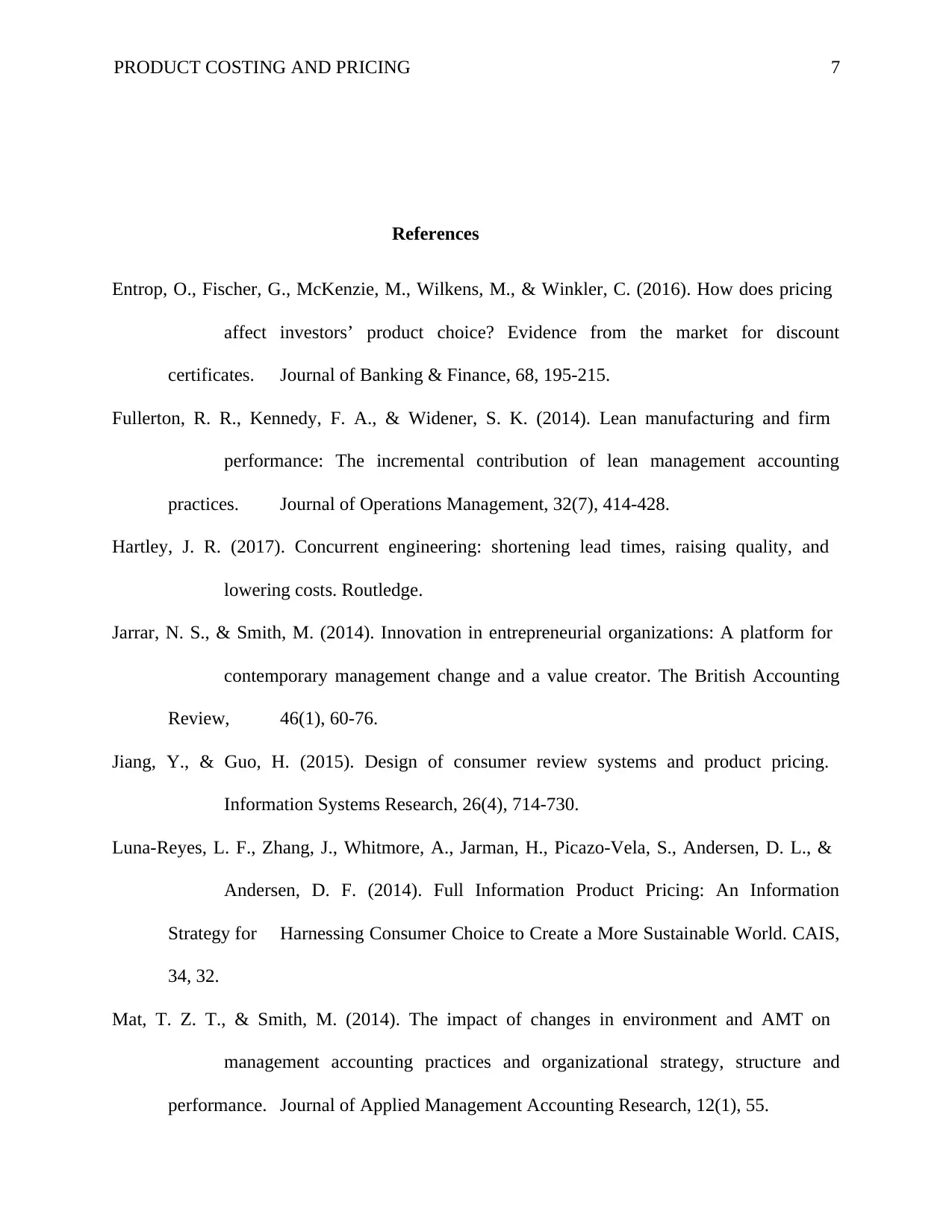
PRODUCT COSTING AND PRICING 7
References
Entrop, O., Fischer, G., McKenzie, M., Wilkens, M., & Winkler, C. (2016). How does pricing
affect investors’ product choice? Evidence from the market for discount
certificates. Journal of Banking & Finance, 68, 195-215.
Fullerton, R. R., Kennedy, F. A., & Widener, S. K. (2014). Lean manufacturing and firm
performance: The incremental contribution of lean management accounting
practices. Journal of Operations Management, 32(7), 414-428.
Hartley, J. R. (2017). Concurrent engineering: shortening lead times, raising quality, and
lowering costs. Routledge.
Jarrar, N. S., & Smith, M. (2014). Innovation in entrepreneurial organizations: A platform for
contemporary management change and a value creator. The British Accounting
Review, 46(1), 60-76.
Jiang, Y., & Guo, H. (2015). Design of consumer review systems and product pricing.
Information Systems Research, 26(4), 714-730.
Luna-Reyes, L. F., Zhang, J., Whitmore, A., Jarman, H., Picazo-Vela, S., Andersen, D. L., &
Andersen, D. F. (2014). Full Information Product Pricing: An Information
Strategy for Harnessing Consumer Choice to Create a More Sustainable World. CAIS,
34, 32.
Mat, T. Z. T., & Smith, M. (2014). The impact of changes in environment and AMT on
management accounting practices and organizational strategy, structure and
performance. Journal of Applied Management Accounting Research, 12(1), 55.
References
Entrop, O., Fischer, G., McKenzie, M., Wilkens, M., & Winkler, C. (2016). How does pricing
affect investors’ product choice? Evidence from the market for discount
certificates. Journal of Banking & Finance, 68, 195-215.
Fullerton, R. R., Kennedy, F. A., & Widener, S. K. (2014). Lean manufacturing and firm
performance: The incremental contribution of lean management accounting
practices. Journal of Operations Management, 32(7), 414-428.
Hartley, J. R. (2017). Concurrent engineering: shortening lead times, raising quality, and
lowering costs. Routledge.
Jarrar, N. S., & Smith, M. (2014). Innovation in entrepreneurial organizations: A platform for
contemporary management change and a value creator. The British Accounting
Review, 46(1), 60-76.
Jiang, Y., & Guo, H. (2015). Design of consumer review systems and product pricing.
Information Systems Research, 26(4), 714-730.
Luna-Reyes, L. F., Zhang, J., Whitmore, A., Jarman, H., Picazo-Vela, S., Andersen, D. L., &
Andersen, D. F. (2014). Full Information Product Pricing: An Information
Strategy for Harnessing Consumer Choice to Create a More Sustainable World. CAIS,
34, 32.
Mat, T. Z. T., & Smith, M. (2014). The impact of changes in environment and AMT on
management accounting practices and organizational strategy, structure and
performance. Journal of Applied Management Accounting Research, 12(1), 55.
Paraphrase This Document
Need a fresh take? Get an instant paraphrase of this document with our AI Paraphraser
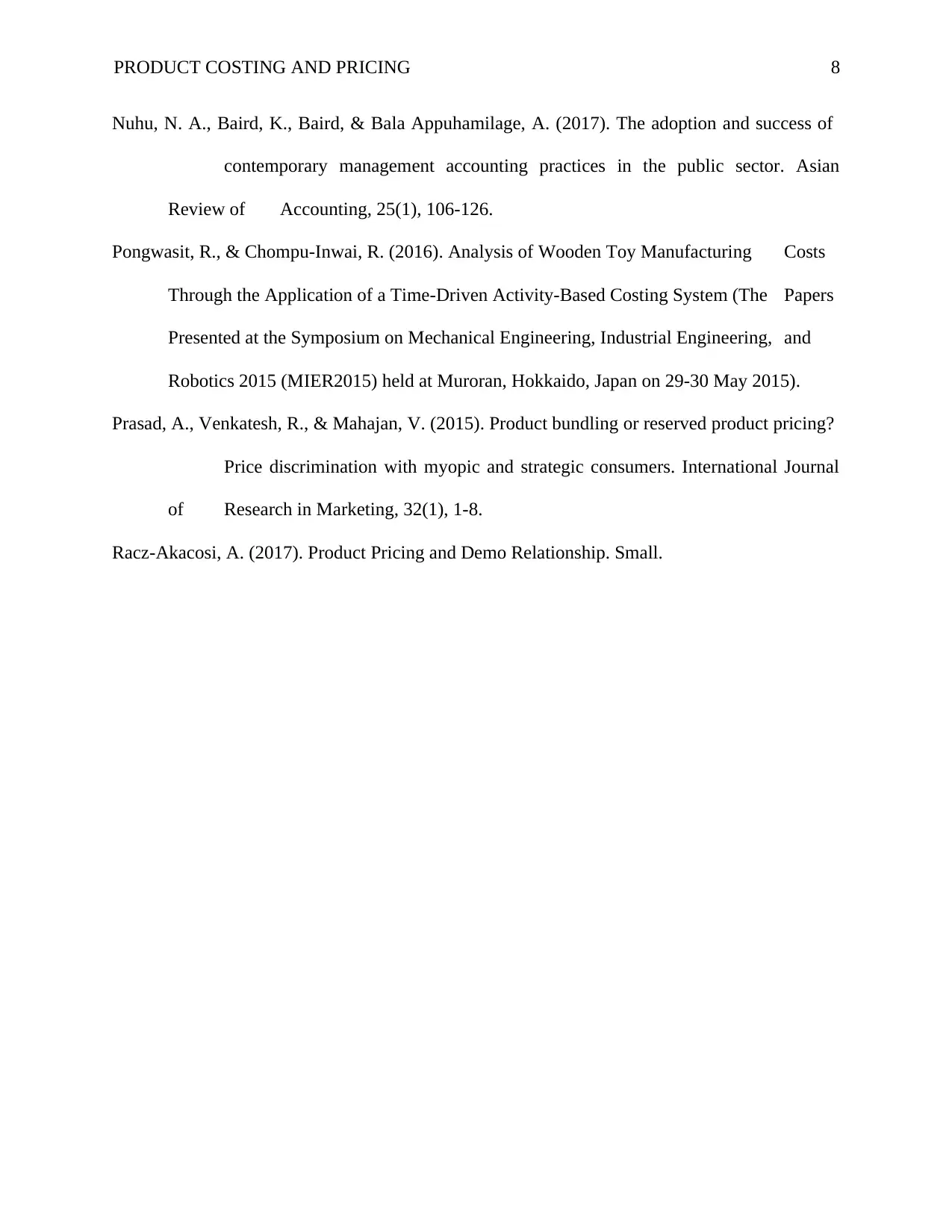
PRODUCT COSTING AND PRICING 8
Nuhu, N. A., Baird, K., Baird, & Bala Appuhamilage, A. (2017). The adoption and success of
contemporary management accounting practices in the public sector. Asian
Review of Accounting, 25(1), 106-126.
Pongwasit, R., & Chompu-Inwai, R. (2016). Analysis of Wooden Toy Manufacturing Costs
Through the Application of a Time-Driven Activity-Based Costing System (The Papers
Presented at the Symposium on Mechanical Engineering, Industrial Engineering, and
Robotics 2015 (MIER2015) held at Muroran, Hokkaido, Japan on 29-30 May 2015).
Prasad, A., Venkatesh, R., & Mahajan, V. (2015). Product bundling or reserved product pricing?
Price discrimination with myopic and strategic consumers. International Journal
of Research in Marketing, 32(1), 1-8.
Racz-Akacosi, A. (2017). Product Pricing and Demo Relationship. Small.
Nuhu, N. A., Baird, K., Baird, & Bala Appuhamilage, A. (2017). The adoption and success of
contemporary management accounting practices in the public sector. Asian
Review of Accounting, 25(1), 106-126.
Pongwasit, R., & Chompu-Inwai, R. (2016). Analysis of Wooden Toy Manufacturing Costs
Through the Application of a Time-Driven Activity-Based Costing System (The Papers
Presented at the Symposium on Mechanical Engineering, Industrial Engineering, and
Robotics 2015 (MIER2015) held at Muroran, Hokkaido, Japan on 29-30 May 2015).
Prasad, A., Venkatesh, R., & Mahajan, V. (2015). Product bundling or reserved product pricing?
Price discrimination with myopic and strategic consumers. International Journal
of Research in Marketing, 32(1), 1-8.
Racz-Akacosi, A. (2017). Product Pricing and Demo Relationship. Small.
1 out of 8
Related Documents
Your All-in-One AI-Powered Toolkit for Academic Success.
+13062052269
info@desklib.com
Available 24*7 on WhatsApp / Email
![[object Object]](/_next/static/media/star-bottom.7253800d.svg)
Unlock your academic potential
© 2024 | Zucol Services PVT LTD | All rights reserved.





